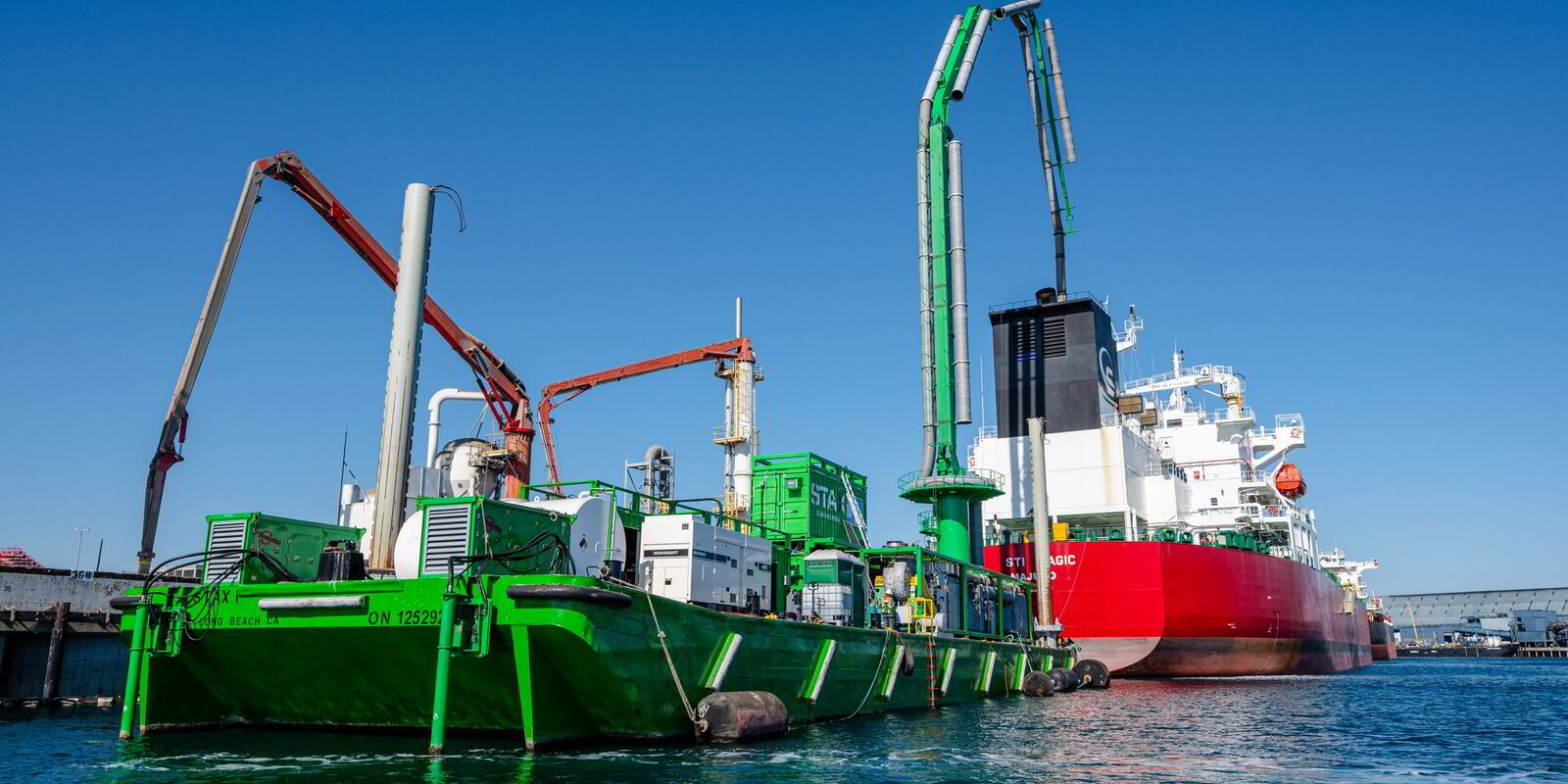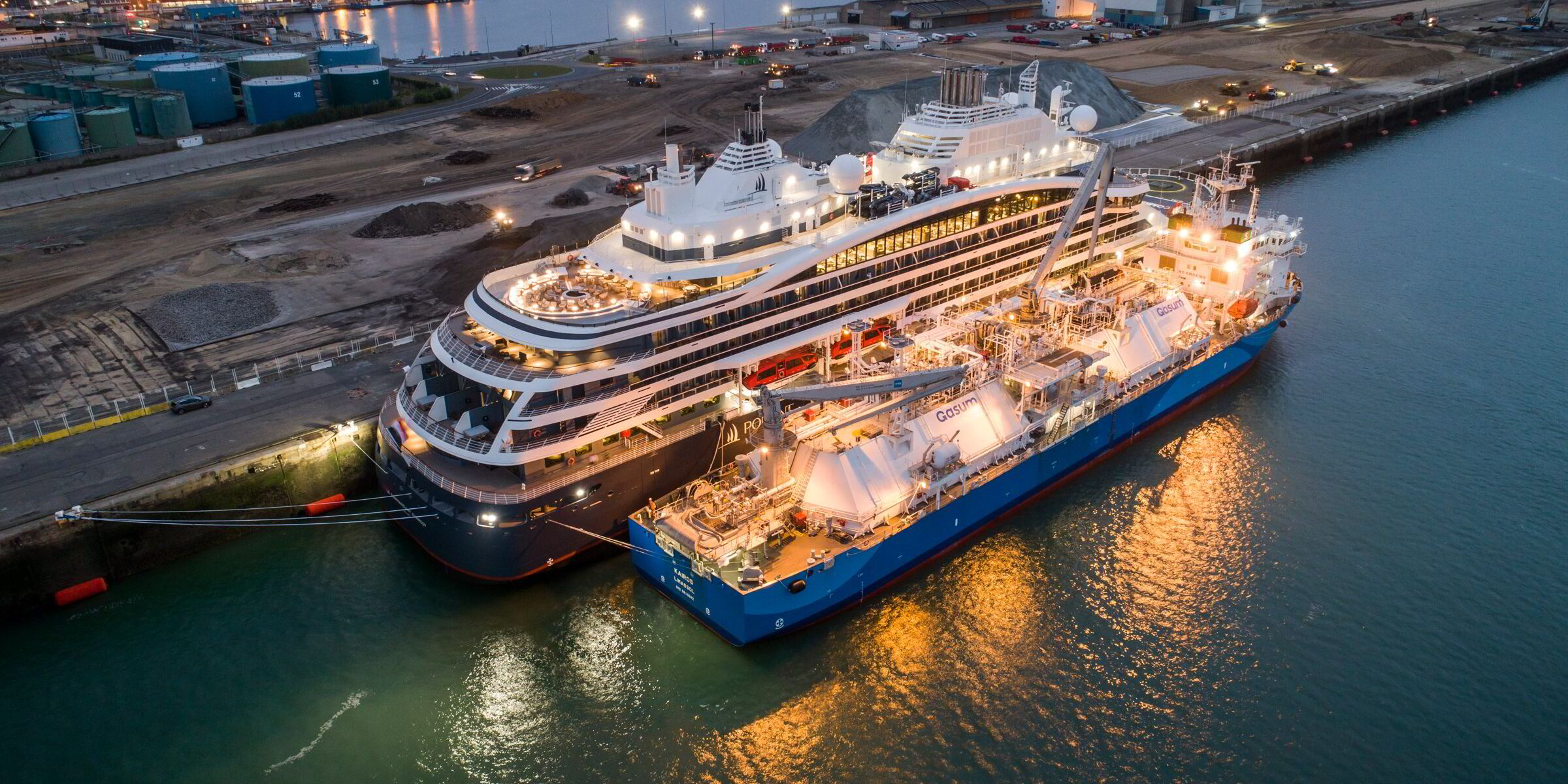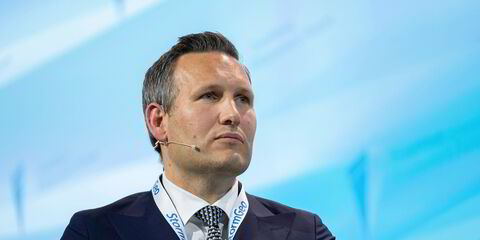STAX Engineering plans to bring its exhaust-emissions collection barge to Europe and the UK after seeing growth in its home ports in California.
The US technology firm has developed a unique system to collect and treat ships’ emissions as they rise out of the funnels of berthed vessels.
Ships using STAX’s system to comply with California’s strict emissions rules are given permits that exempt them from having to fit new technologies, use expensive fuels or connect to onshore power.

The California Air Resources Board (CARB) expanded its 2020 emissions control regulations, which were limited to container ships, and from 1 January this year all ro-ro vessels are included.
Tankers calling at terminals in the ports of Los Angeles and Long Beach are also included.
From 2027, the rules will extend to all tankers calling at any California terminal.
The rules state that vessels need to connect to shore electricity and switch off their engines.
STAX and other companies in California have been developing ship exhaust capture technologies under the guidance of CARB. The California at-berth emission rules apply to NOx and particulate matter.

The solution is elegant in its simplicity.
A selective catalytic converter and a particulate matter filter are installed on a mobile bed, such as a barge, which is then connected to the top of a ship’s funnel using a long telescopic arm.
The ship’s emissions are then treated as they flow out of the funnel.
The actual application is somewhat more complex, STAX chief executive Mike Walker explained as told TradeWinds’ Green Seas podcast about the company’s expansion plans.
The technology needs to be remotely controlled and able to lower the funnel cap quickly and without the ship needing to switch off its auxiliary engines — most vessels switch to auxiliary generators only when alongside, putting main engines on standby.
“One advantage we have is the huge long arm and the spud [alignment] system, so can move around the vessel to get into the best position for a vessel,” Walker said.
“The exhaust goes through a diesel particulate filter, then through a heat exchanger and into the SCR [selective catalytic reduction system] where the nitrogen and oxygen are separated with urea. The output then is CO2 and additional oxygen.”
The focus has been on barge-based solutions, as many terminals have space restrictions shoreside for a system close to the berth, and some carriers STAX has contracts with will call at different berths.
Walker said the challenge from 1 January this year has been the shortage of onshore electricity connections for vessels in California.
This has meant they have had to rapidly expand their fleet of units to service all the vessels and their requirements.
“We have signed exclusive contacts with terminals and guarantees with carriers to ensure they have a STAX unit, and then we need to deliver on that,” he said.
The STAX website displays press releases revealing its contracts with West Coast terminals, ports and carriers with vessels visiting California.
Walker said STAX investors understood both the challenges and the opportunities, and they stepped in to finance the build of about $150m worth of units.
“We had the right partners and contractors, so now we have five units operational, three more in Long Beach in the coming week and a further five more in the year,” he said.
By 2027, when the tankers calling at ports across California fall under the regulations, STAX could have 27 to 30 units in service, Walker said.

Europe and UK
Buoyed by their experience in California, Walker said STAX has its eyes on the European Union and the UK.
He has been on business trips to Brussels and to the UK to look at opportunities.
He has met with rule makers and port associations to see what the possibilities are and hopes to be able to run a demonstration project soon.
European regulations are clearer than those of the UK.
Major European ports need to have onshore power supply solutions available by the end of 2029, according to the Alternative Fuel Infrastructure Directive.
Under FuelEU Maritime, certain vessels need to connect to the onshore power system from 1 January 2030.
According to the European Alternative Fuel Observatory, there are 680 berths at 94 ports in Europe offering onshore power today, with Norway having the majority.
Walker said he believes the UK’s, now delayed, maritime strategy will include some mention of regulating emissions at berths.
Carbon capture in a port
The next step for in-port emissions capture, according to Walker, is going to be carbon capture.
He told TradeWinds STAX has begun talks with a UK-based company that is developing carbon capture technology that can be installed on vessels.
STAX plans on announcing more about the partnership, including trials of the technology on one of the company’s barges in the US, later this month.
California Air Resources Board
Oceangoing vessels at-berth regulations:
1 January 2023: To container ships, reefer vessels and cruise ships.
1 January 2025: To ro-ros and tankers calling at berths in the Port of Long Beach and Port of Los Angeles
1 January 2027: To all tankers calling in California delegated ports.
European Union regulations
Alternative fuels infrastructure regulation (2023/1804)
By the end of 31 December 2029 all major ports (with at least 40 port calls of each ship type per annum) need to be able to supply onshore electricity to at least 90% of the port calls of container ships, ro-ros and passenger ships of 5,000 gt and larger.
Under the FuelEU Maritime regulation (2023/1805)
FuelEU Maritime stipulates that, from 1 January 2030, container ships, ro-ros and passenger ships that call at major ports are obliged to use shore power if their port stay is longer than two hours. Vessels using approved zero-emission technologies, such as fuel cells and batteries, are exempt, but the regulation does not list in-port vessel emissions capture as a method. However, it does suggest other technologies can be approved in the future.(Copyright)




